A Report on Criminal Cases That Crossed International Boundaries
VerifiedAdded on 2019/10/30
|5
|983
|229
Report
AI Summary
This report provides an in-depth analysis of cross-border economic crimes, focusing on two significant case studies from the 21st century: the Citibank case and the George Hourmouzis case. The Citibank case involves a Russian computer hacking conspiracy to steal millions from customer accounts, while the Hourmouzis case highlights internet-facilitated stock manipulation. The report examines the criminal justice concerns associated with these cases, including jurisdictional challenges and the use of technology in crime. It also explores prevention and control strategies, such as information sharing, collaboration between regulatory and law enforcement agencies, and the establishment of central repositories for reporting cybercrimes. The analysis draws upon legal and criminological literature to provide a comprehensive understanding of cross-border crime and potential reforms.
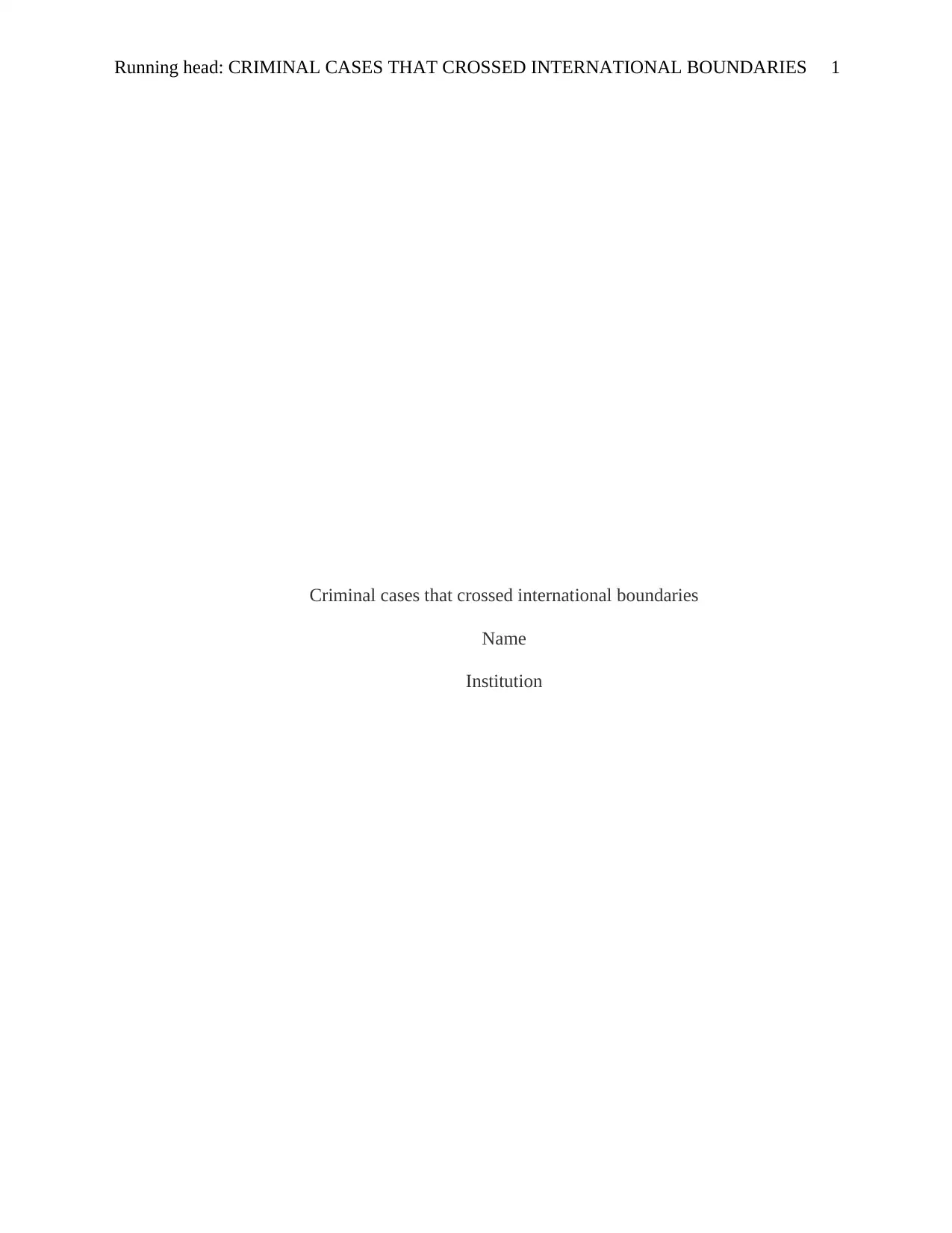
Running head: CRIMINAL CASES THAT CROSSED INTERNATIONAL BOUNDARIES 1
Criminal cases that crossed international boundaries
Name
Institution
Criminal cases that crossed international boundaries
Name
Institution
Paraphrase This Document
Need a fresh take? Get an instant paraphrase of this document with our AI Paraphraser
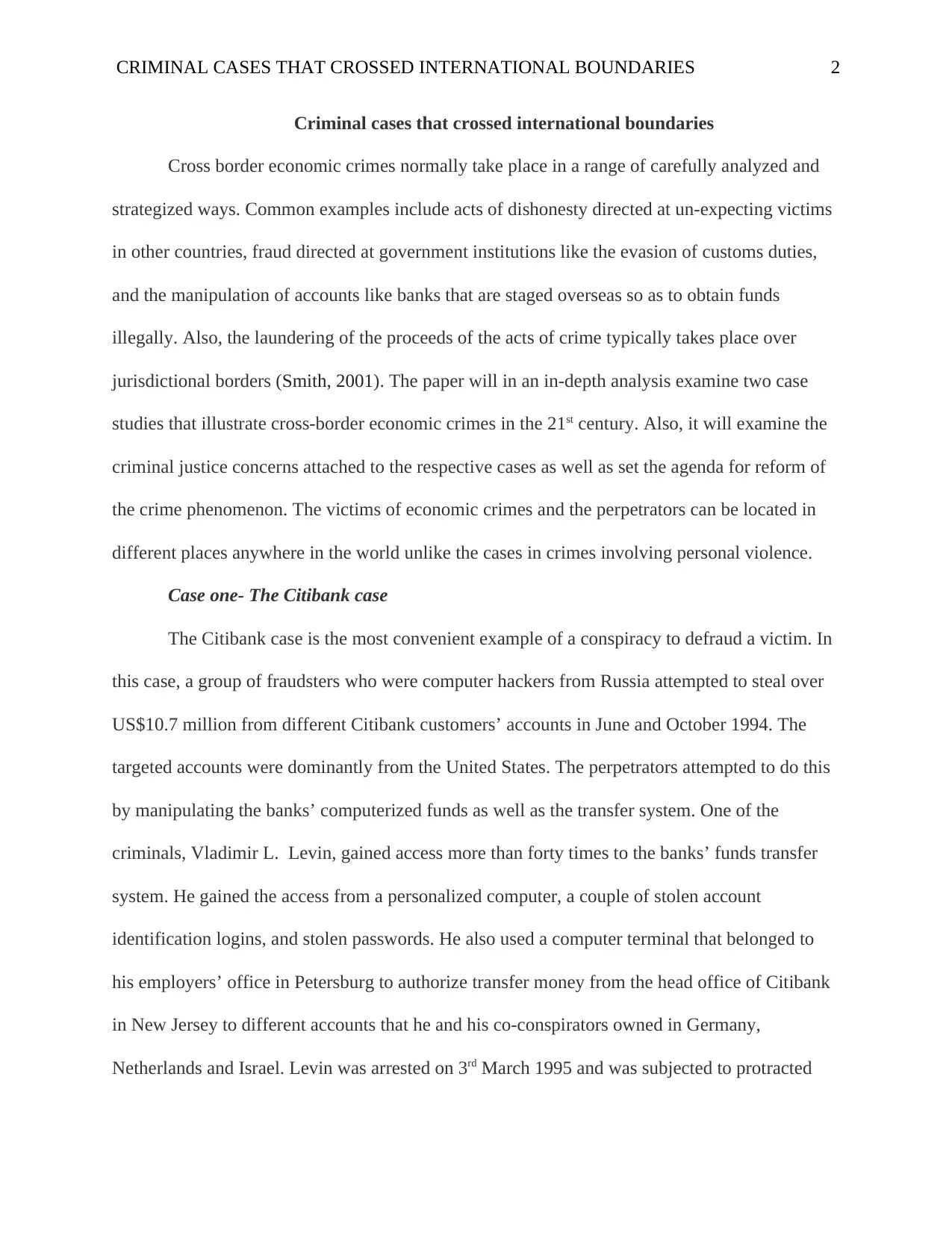
CRIMINAL CASES THAT CROSSED INTERNATIONAL BOUNDARIES 2
Criminal cases that crossed international boundaries
Cross border economic crimes normally take place in a range of carefully analyzed and
strategized ways. Common examples include acts of dishonesty directed at un-expecting victims
in other countries, fraud directed at government institutions like the evasion of customs duties,
and the manipulation of accounts like banks that are staged overseas so as to obtain funds
illegally. Also, the laundering of the proceeds of the acts of crime typically takes place over
jurisdictional borders (Smith, 2001). The paper will in an in-depth analysis examine two case
studies that illustrate cross-border economic crimes in the 21st century. Also, it will examine the
criminal justice concerns attached to the respective cases as well as set the agenda for reform of
the crime phenomenon. The victims of economic crimes and the perpetrators can be located in
different places anywhere in the world unlike the cases in crimes involving personal violence.
Case one- The Citibank case
The Citibank case is the most convenient example of a conspiracy to defraud a victim. In
this case, a group of fraudsters who were computer hackers from Russia attempted to steal over
US$10.7 million from different Citibank customers’ accounts in June and October 1994. The
targeted accounts were dominantly from the United States. The perpetrators attempted to do this
by manipulating the banks’ computerized funds as well as the transfer system. One of the
criminals, Vladimir L. Levin, gained access more than forty times to the banks’ funds transfer
system. He gained the access from a personalized computer, a couple of stolen account
identification logins, and stolen passwords. He also used a computer terminal that belonged to
his employers’ office in Petersburg to authorize transfer money from the head office of Citibank
in New Jersey to different accounts that he and his co-conspirators owned in Germany,
Netherlands and Israel. Levin was arrested on 3rd March 1995 and was subjected to protracted
Criminal cases that crossed international boundaries
Cross border economic crimes normally take place in a range of carefully analyzed and
strategized ways. Common examples include acts of dishonesty directed at un-expecting victims
in other countries, fraud directed at government institutions like the evasion of customs duties,
and the manipulation of accounts like banks that are staged overseas so as to obtain funds
illegally. Also, the laundering of the proceeds of the acts of crime typically takes place over
jurisdictional borders (Smith, 2001). The paper will in an in-depth analysis examine two case
studies that illustrate cross-border economic crimes in the 21st century. Also, it will examine the
criminal justice concerns attached to the respective cases as well as set the agenda for reform of
the crime phenomenon. The victims of economic crimes and the perpetrators can be located in
different places anywhere in the world unlike the cases in crimes involving personal violence.
Case one- The Citibank case
The Citibank case is the most convenient example of a conspiracy to defraud a victim. In
this case, a group of fraudsters who were computer hackers from Russia attempted to steal over
US$10.7 million from different Citibank customers’ accounts in June and October 1994. The
targeted accounts were dominantly from the United States. The perpetrators attempted to do this
by manipulating the banks’ computerized funds as well as the transfer system. One of the
criminals, Vladimir L. Levin, gained access more than forty times to the banks’ funds transfer
system. He gained the access from a personalized computer, a couple of stolen account
identification logins, and stolen passwords. He also used a computer terminal that belonged to
his employers’ office in Petersburg to authorize transfer money from the head office of Citibank
in New Jersey to different accounts that he and his co-conspirators owned in Germany,
Netherlands and Israel. Levin was arrested on 3rd March 1995 and was subjected to protracted
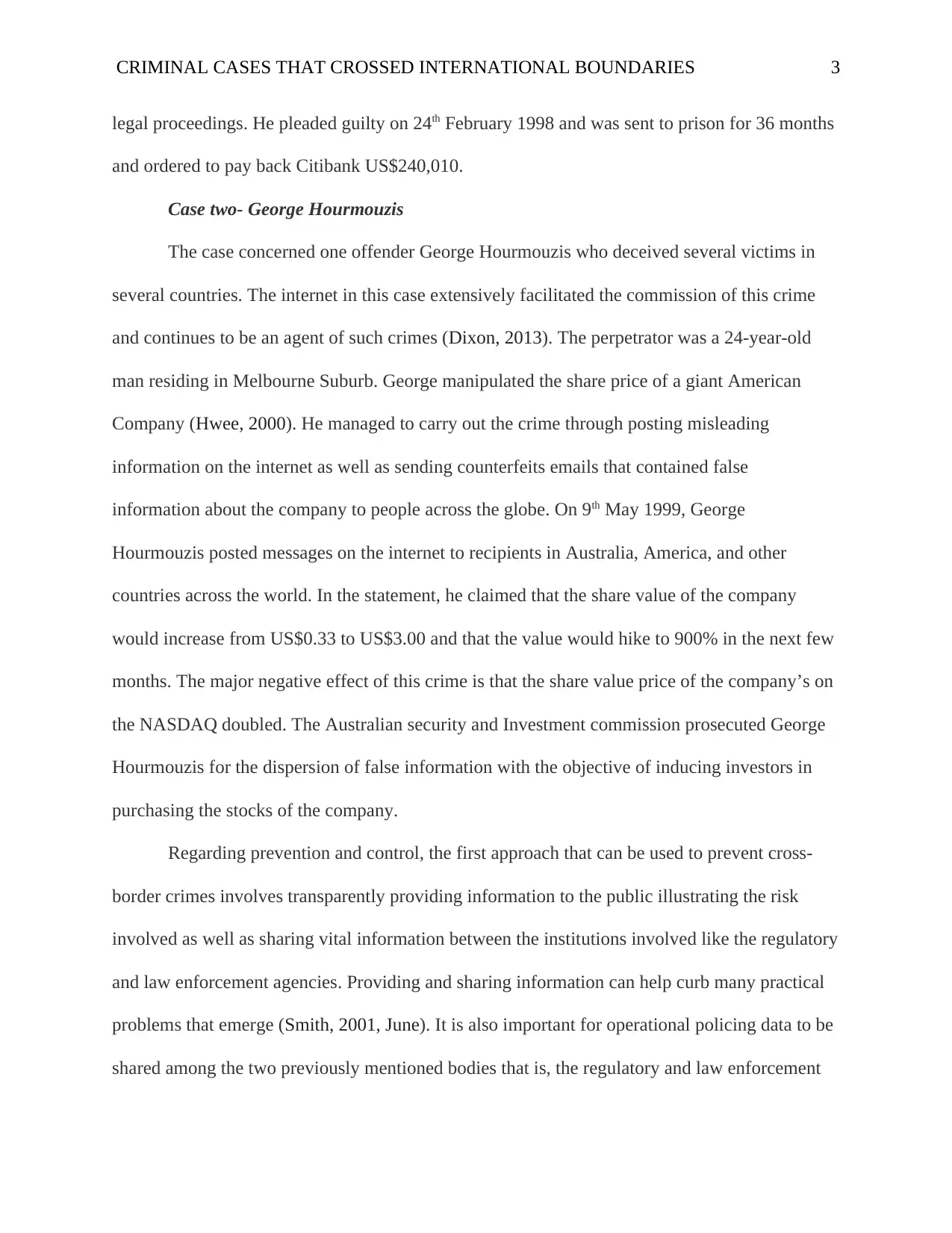
CRIMINAL CASES THAT CROSSED INTERNATIONAL BOUNDARIES 3
legal proceedings. He pleaded guilty on 24th February 1998 and was sent to prison for 36 months
and ordered to pay back Citibank US$240,010.
Case two- George Hourmouzis
The case concerned one offender George Hourmouzis who deceived several victims in
several countries. The internet in this case extensively facilitated the commission of this crime
and continues to be an agent of such crimes (Dixon, 2013). The perpetrator was a 24-year-old
man residing in Melbourne Suburb. George manipulated the share price of a giant American
Company (Hwee, 2000). He managed to carry out the crime through posting misleading
information on the internet as well as sending counterfeits emails that contained false
information about the company to people across the globe. On 9th May 1999, George
Hourmouzis posted messages on the internet to recipients in Australia, America, and other
countries across the world. In the statement, he claimed that the share value of the company
would increase from US$0.33 to US$3.00 and that the value would hike to 900% in the next few
months. The major negative effect of this crime is that the share value price of the company’s on
the NASDAQ doubled. The Australian security and Investment commission prosecuted George
Hourmouzis for the dispersion of false information with the objective of inducing investors in
purchasing the stocks of the company.
Regarding prevention and control, the first approach that can be used to prevent cross-
border crimes involves transparently providing information to the public illustrating the risk
involved as well as sharing vital information between the institutions involved like the regulatory
and law enforcement agencies. Providing and sharing information can help curb many practical
problems that emerge (Smith, 2001, June). It is also important for operational policing data to be
shared among the two previously mentioned bodies that is, the regulatory and law enforcement
legal proceedings. He pleaded guilty on 24th February 1998 and was sent to prison for 36 months
and ordered to pay back Citibank US$240,010.
Case two- George Hourmouzis
The case concerned one offender George Hourmouzis who deceived several victims in
several countries. The internet in this case extensively facilitated the commission of this crime
and continues to be an agent of such crimes (Dixon, 2013). The perpetrator was a 24-year-old
man residing in Melbourne Suburb. George manipulated the share price of a giant American
Company (Hwee, 2000). He managed to carry out the crime through posting misleading
information on the internet as well as sending counterfeits emails that contained false
information about the company to people across the globe. On 9th May 1999, George
Hourmouzis posted messages on the internet to recipients in Australia, America, and other
countries across the world. In the statement, he claimed that the share value of the company
would increase from US$0.33 to US$3.00 and that the value would hike to 900% in the next few
months. The major negative effect of this crime is that the share value price of the company’s on
the NASDAQ doubled. The Australian security and Investment commission prosecuted George
Hourmouzis for the dispersion of false information with the objective of inducing investors in
purchasing the stocks of the company.
Regarding prevention and control, the first approach that can be used to prevent cross-
border crimes involves transparently providing information to the public illustrating the risk
involved as well as sharing vital information between the institutions involved like the regulatory
and law enforcement agencies. Providing and sharing information can help curb many practical
problems that emerge (Smith, 2001, June). It is also important for operational policing data to be
shared among the two previously mentioned bodies that is, the regulatory and law enforcement
⊘ This is a preview!⊘
Do you want full access?
Subscribe today to unlock all pages.

Trusted by 1+ million students worldwide
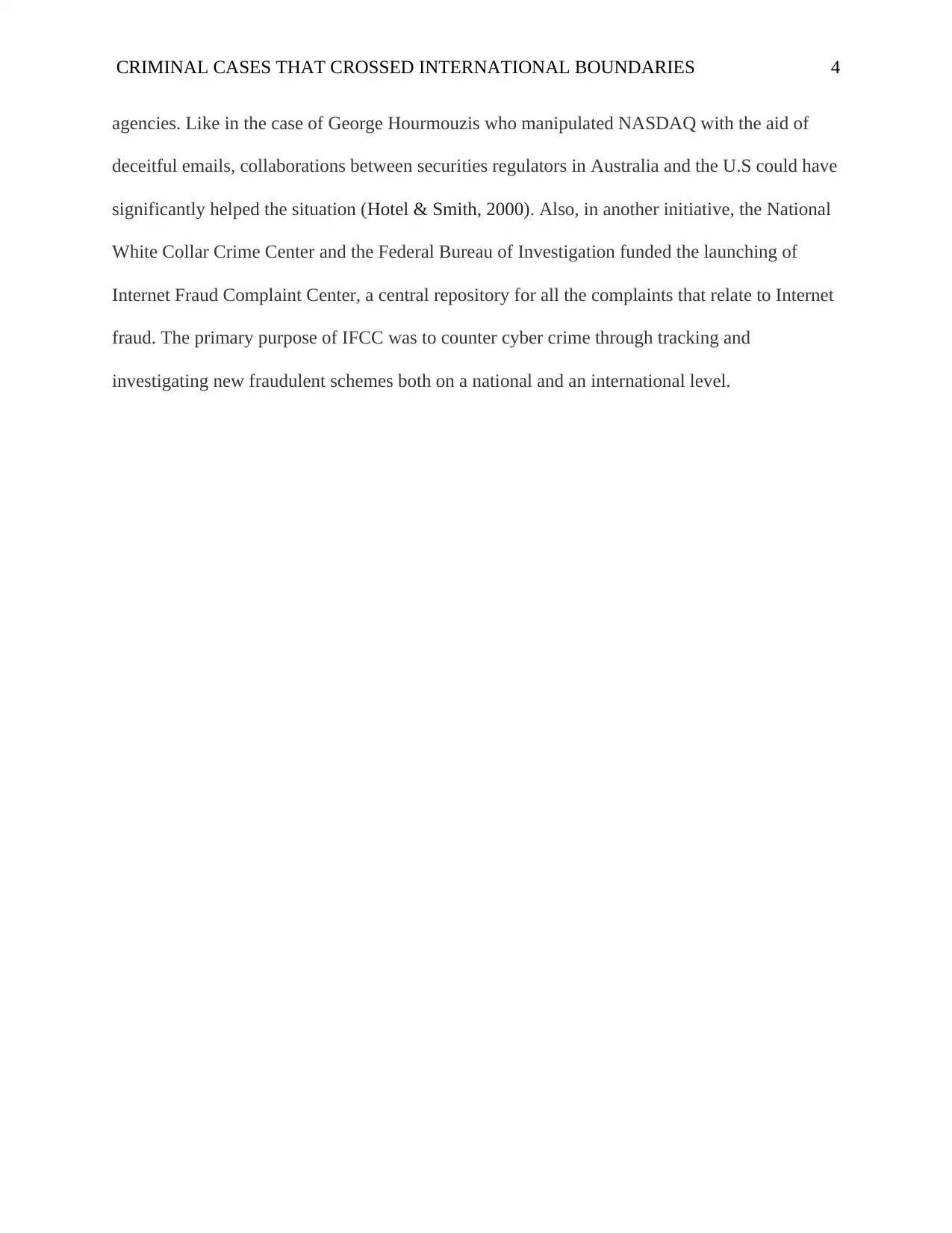
CRIMINAL CASES THAT CROSSED INTERNATIONAL BOUNDARIES 4
agencies. Like in the case of George Hourmouzis who manipulated NASDAQ with the aid of
deceitful emails, collaborations between securities regulators in Australia and the U.S could have
significantly helped the situation (Hotel & Smith, 2000). Also, in another initiative, the National
White Collar Crime Center and the Federal Bureau of Investigation funded the launching of
Internet Fraud Complaint Center, a central repository for all the complaints that relate to Internet
fraud. The primary purpose of IFCC was to counter cyber crime through tracking and
investigating new fraudulent schemes both on a national and an international level.
agencies. Like in the case of George Hourmouzis who manipulated NASDAQ with the aid of
deceitful emails, collaborations between securities regulators in Australia and the U.S could have
significantly helped the situation (Hotel & Smith, 2000). Also, in another initiative, the National
White Collar Crime Center and the Federal Bureau of Investigation funded the launching of
Internet Fraud Complaint Center, a central repository for all the complaints that relate to Internet
fraud. The primary purpose of IFCC was to counter cyber crime through tracking and
investigating new fraudulent schemes both on a national and an international level.
Paraphrase This Document
Need a fresh take? Get an instant paraphrase of this document with our AI Paraphraser
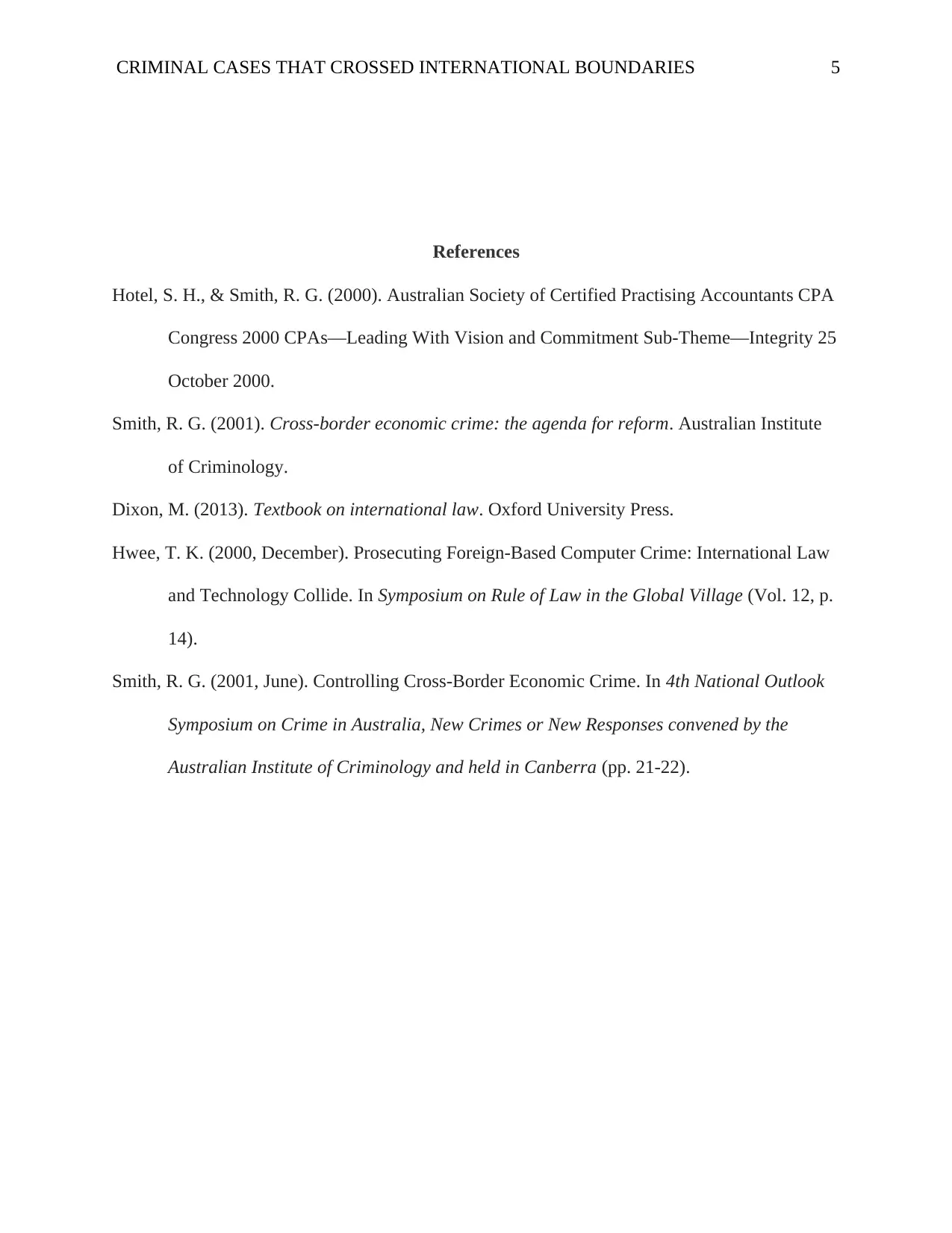
CRIMINAL CASES THAT CROSSED INTERNATIONAL BOUNDARIES 5
References
Hotel, S. H., & Smith, R. G. (2000). Australian Society of Certified Practising Accountants CPA
Congress 2000 CPAs—Leading With Vision and Commitment Sub-Theme—Integrity 25
October 2000.
Smith, R. G. (2001). Cross-border economic crime: the agenda for reform. Australian Institute
of Criminology.
Dixon, M. (2013). Textbook on international law. Oxford University Press.
Hwee, T. K. (2000, December). Prosecuting Foreign-Based Computer Crime: International Law
and Technology Collide. In Symposium on Rule of Law in the Global Village (Vol. 12, p.
14).
Smith, R. G. (2001, June). Controlling Cross-Border Economic Crime. In 4th National Outlook
Symposium on Crime in Australia, New Crimes or New Responses convened by the
Australian Institute of Criminology and held in Canberra (pp. 21-22).
References
Hotel, S. H., & Smith, R. G. (2000). Australian Society of Certified Practising Accountants CPA
Congress 2000 CPAs—Leading With Vision and Commitment Sub-Theme—Integrity 25
October 2000.
Smith, R. G. (2001). Cross-border economic crime: the agenda for reform. Australian Institute
of Criminology.
Dixon, M. (2013). Textbook on international law. Oxford University Press.
Hwee, T. K. (2000, December). Prosecuting Foreign-Based Computer Crime: International Law
and Technology Collide. In Symposium on Rule of Law in the Global Village (Vol. 12, p.
14).
Smith, R. G. (2001, June). Controlling Cross-Border Economic Crime. In 4th National Outlook
Symposium on Crime in Australia, New Crimes or New Responses convened by the
Australian Institute of Criminology and held in Canberra (pp. 21-22).
1 out of 5
Your All-in-One AI-Powered Toolkit for Academic Success.
+13062052269
info@desklib.com
Available 24*7 on WhatsApp / Email
![[object Object]](/_next/static/media/star-bottom.7253800d.svg)
Unlock your academic potential
Copyright © 2020–2025 A2Z Services. All Rights Reserved. Developed and managed by ZUCOL.
